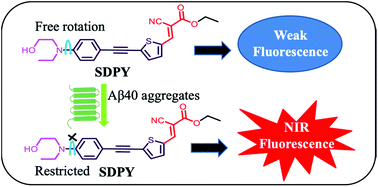Novel D–π-A type near-infrared fluorescent probes for the detection of Aβ40 aggregates†
Abstract
Aberrant accumulation of Amyloid-β (Aβ) peptide is closely related to Alzheimer's disease. Thus, it is important to develop featured probes for the specific detection of Aβ species. Herein, we designed and synthesized a novel near-infrared fluorescent probe SDPY based on the D–π-A architecture for the detection of Aβ aggregates. The probe SDPY displayed higher affinity for Aβ40 aggregates over Aβ42 aggregates in solution (Kd = 164 nM vs. 2.1 μM). In addition, SDPY showed excellent anti-interference against a wide range of other substances. Furthermore, SDPY was capable of labeling Aβ40 aggregates better than Aβ42 aggregates in the brain sections of AD transgenic mouse models.



 Please wait while we load your content...
Please wait while we load your content...